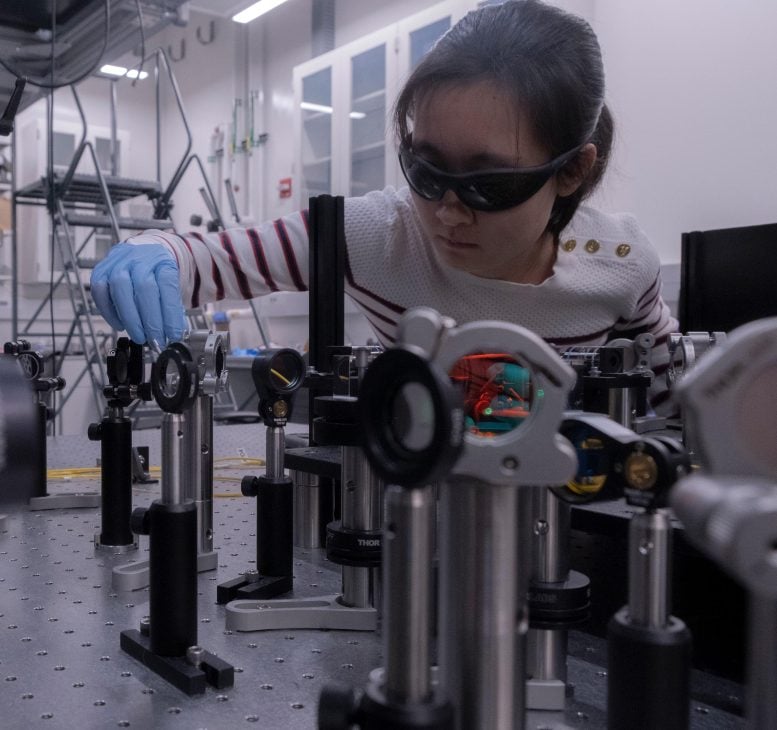
Atomic antennas using diamonds enhance optical energy by a million-fold, enabling new physics research. This was achieved through global collaboration between theory and experiments. Credit: SciTechDaily.com
Theory has become practice as new work from the <span class="glossaryLink" aria-describedby="tt" data-cmtooltip="
” data-gt-translate-attributes=”[{"attribute":"data-cmtooltip", "format":"html"}]” tabindex=”0″ role=”link”>University of Chicago Pritzker School of Molecular Engineering taps diamond defects’ remarkable ability to concentrate optical energy.
Researchers have developed atomic antennas using germanium vacancy centers in diamonds, achieving a million-fold optical energy enhancement. This advancement allows the study of fundamental physics and opens new research avenues. The collaboration between theoretical and experimental teams was essential to this breakthrough.
Atomic Antennas: Harnessing Light for Powerful Signals
Similar to how a radio antenna captures a broadcast from the air and concentrates the energy into music, individual atoms can collect and concentrate the energy of light into a strong, localized signal that researchers can use to investigate the fundamental building blocks of matter.
The more powerful the intensity enhancement, the better the antenna. However, scientists have never been able to tap the potentially huge intensity enhancements of some “atomic antennas” in solid materials simply because they were solids.
Overcoming the Challenges of Solid Materials
“Most of the time when you have atoms in solids, they interact with the environment. There’s a lot of disorder, they get shaken by phonons and face other disruptions that reduce the coherence of the signal,” said UChicago Pritzker School of Molecular Engineering Assistant Professor Alex High.
In a new paper published on June 7 in <span class="glossaryLink" aria-describedby="tt" data-cmtooltip="
” data-gt-translate-attributes=”[{"attribute":"data-cmtooltip", "format":"html"}]” tabindex=”0″ role=”link”>Nature Photonics, a multi-institutional team led by the High Lab has cracked this problem. They have used germanium vacancy centers in diamonds to create an optical energy enhancement of six orders of magnitude, a regime challenging to reach with conventional antenna structures.

PhD candidate Zixi Li at the UChicago Pritzker School of Molecular Engineering is the co-first author on a new paper from the lab of Asst. Prof. Alex High, which demonstrates a new way to provide more powerful measurements on the atomic level. Credit: Photo by Hong Qiao / UChicago Pritzker School of Molecular Engineering
Groundbreaking Optical Antennas With Diamonds
This million-fold energy enhancement creates what the paper calls an “exemplary” optical antenna and provides a new tool opening up entirely new research areas.
“It’s not just a breakthrough in technology. It’s also a breakthrough in fundamental physics,” said PME PhD candidate Zixi Li, co-first author on the paper. “While it’s well-known that an excited atomic dipole can generate a near-filed with huge intensity, no one has ever demonstrated this in an experiment before.”
From Theory to Practice: Realizing Optical Antennas
The core feature of an optical antenna is that it creates an oscillating electronic dipole when excited at resonance.
“Optical antennas are basically structures that interact with electromagnetic fields and absorb or emit light at certain resonances, like the electrons moving between energy levels in these color centers,” High said.
The electron oscillates when it transitions between an excited state and a ground state and concentrates a comparatively huge amount of energy, making an atomic optical dipole in a solid an excellent antenna – theoretically.
“It’s not just a breakthrough in technology. It’s also a breakthrough in fundamental physics.”
— UChicago Pritzker School of Molecular Engineering PhD candidate Zixi Li
Addressing the Challenges in Solid-State Atoms
What kept that ability theoretical was the fact the atoms were in solids, subject to all the jostling, electron interference and general noise that comes from being part of a tightly-packed structure. Color centers – small defects in diamonds and other materials with interesting quantum properties – provided the team a solution.
“Something that’s been observed for the last seven or eight years is that certain types of color centers can be immune to these environmental effects,” High said.
Potential of Quantum Mechanical Light Emission
This opens intriguing research opportunities, said co-author Darrick Chang of the Institute of Photonic Sciences in Barcelona, Spain.
“To me, the most interesting aspect of a color center is not just the field enhancement, but also the fact that the emitted light is intrinsically quantum mechanical,” he said. “That makes it intriguing to consider whether a ‘quantum optical antenna’ can have a different set of functionalities and working mechanisms as compared to a classical optical antenna.”
Collaborations Paving the Way for Innovations
But turning this theory into a practicable antenna took years, collaboration with researchers around the globe and theoretical guidance from UChicago’s Galli Group.
“The collaboration between theory, computation and experiments initiated by Alex High not only contributed to understanding and interpreting the core science, but also opened new lines of research on the computational side,” said PME Liew Family Prof. Guilia Galli, a co-author on the paper. “The collaboration has been extremely fruitful.”
‘The Magic of a Color Center’
Imaging at the atomic level is a combination of amplification and bandwidth – the strength of the signal and the amount of signal you can study. Because of this, co-first author Xinghan Guo sees the new technique as complementary to, not replacing, existing techniques.
“We offer a much higher amplification but our bandwidth is narrower,” said Guo, who recently completed his PhD at PME and is now a postdoctoral researcher at Yale. “If you have a very selective signal which has a narrow bandwidth but requires a lot of amplification, you can come to us.”
Advantages of New Techniques
The new technique offers other benefits than just a more powerful signal. While existing techniques like single-molecule Raman and FRET spectroscopy boost the signal by blasting it with light, this technique only requires nanowatts of energy to activate. This means a strong signal without the bleaching, heating and background fluorescence that excessive light creates.
The germanium vacancy centers also do not dissipate energy as they are used, unlike conventional plasmonic antennas.
“The magic of a color center is that it is simultaneously point-like and avoids the losses of a plasmonic material, allowing it to retain its extreme field enhancement,” Chang said.
Future Discoveries With Optical Antennas
For High, the exciting part is not the new form of antenna, but the potential discoveries they will make.
“What’s exciting is that this is a general feature,” High said. “We can integrate these color centers into a huge range of systems, and then we can use these as local antennas to grow new processes that both build new devices and help us understand how the universe works.”
Reference: “Atomic optical antennas in solids” by Zixi Li, Xinghan Guo, Yu Jin, Francesco Andreoli, Anil Bilgin, David D. Awschalom, Nazar Delegan, F. Joseph Heremans, Darrick Chang, Giulia Galli and Alexander A. High, 7 June 2024, Nature Photonics.
DOI: 10.1038/s41566-024-01456-5
Funding: Q-NEXT, supported by the US Department of Energy, Office of Science, National Quantum Information Science Research Centers. Z.L. acknowledges support from the Kadanoff-Rice fellowship (grant no. NSF DMR-2011854). Diamond growth-related efforts were supported by the US Department of Energy, Office of Basic Energy Sciences, Materials Science and Engineering Division.
